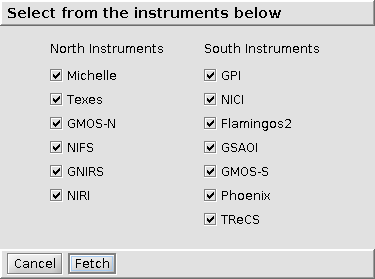The Observing Tool libraries contain complete example observations as well as templates of observations, e.g. commonly used configurations, sequences, standard calibrations and ancillary information which may be copy-and-pasted into a new observation. The intent of these libraries is to speed the development of new science programs. As observing procedures and instrument configurations may change from semester to semester (installation of new GCAL filters, for instance), it is advisable that PIs download the most recent libraries when defining new observations.
Several features in the OT make it easy to fetch the libraries and keep them updated. Clicking on the Libraries button in the Program Editor main toolbar will cause the OT to search the local program database for the libraries for all instruments used by the program in the Program Editor. If those libraries are not in the local database and the computer is online, then the libraries will be fetched automatically. The libraries will then be loaded into a new OT window. If more than one library is loaded, then they can be accessed using the Previous/Next arrows.
![]() Note that the OT cannot automatically check for new versions of the libraries. We recommend that the libraries be fetched manually (see below) at the beginning of every Phase 2 preparation period.
Note that the OT cannot automatically check for new versions of the libraries. We recommend that the libraries be fetched manually (see below) at the beginning of every Phase 2 preparation period.
The libraries can be fetched at any time using the Fetch Libraries option from the File menu. This should be used instead of the regular Fetch option for getting the OT libraries. After Fetch Libraries is chosen the following window appears and the libraries to be fetched are selected.

Clicking Fetch will cause the libraries to be downloaded. If a library already exists in the local database then the user will be prompted if they want to continue.

The current libraries have the program ids mentioned in the table below and are most easily accessed with the Library button on the main toolbar.
Libraries of mid-infrared standard stars and asteroids are available For MICHELLE and T-ReCS. These three OT libraries do not contain full observations, but they do have the proper "Target" components for all the standard stars, with proper PWFS guide stars defined. These target components can be copied into other programs as needed. The first of these libraries contains a smaller set of primary and secondary standards, from somewhat disparate sources. The second library includes all the stars listed on the Cohen spectroscopic standard stars page, from Cohen et al. (1999), and the third contains asteroids useful for high-resolution spectroscopic observations. Although the files are labelled "MICHELLE" standards, they are of course equally useful for T-ReCS programs. These three libraries will be fetched automatically with the MICHELLE OT library.
The following OT libraries are available:
| Site/Instrument | Program Reference |
| Gemini North | |
| GMOS-N | GN-GMOS-library |
| GNIRS | GN-GNIRS-library |
| GRACES | GN-GRACES-library |
| Michelle* | GN-MICHELLE-library |
| GN-CAL-MICHELLE-Standards | |
| GN-CAL-MICHELLE-COHENall | |
| GN-CAL-MICHELLE-Asteroids | |
| NIFS | GN-NIFS-library |
| NIRI | GN-NIRI-library |
| TEXES | GN-TEXES-library |
| Gemini South | |
| FLAMINGOS-2 | GS-Flamingos2-library |
| GMOS-S | GS-GMOS-library |
| GPI | GS-GPI-library |
| GSAOI | GS-GSAOI-library |
| NICI* | GS-NICI-library |
| Phoenix | GS-PHOENIX-library |
| T-ReCS* | GS-TReCS-library |
* The libraries for MICHELLE, T-RECS, and NICI are for reference only as these instruments are currently not in use.